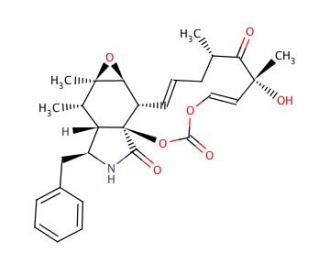

Cytochalasin E, Aspergillus clavatus (CAS 36011-19-5)
See product citations (4)
QUICK LINKS
Cytochalasin E, a derivative of Aspergillus clavatus, is part of the Cytochalasin class of fungal toxins, known for their complex structure, including a highly substituted hydrogenated isoindole ring fused to a macrocyclic ring. This compound is particularly utilized in research to explore actin polymerization and its impact on actin dynamics. It functions by binding to the barbed end of actin filaments, which blocks both the addition and removal of actin subunits, thereby disrupting the polymerization of actin. This disruption significantly affects various cellular activities reliant on actin, such as movement, division, and internalization processes. Cytochalasin E, Aspergillus clavatus serves as a critical tool in delving into the intricate behaviors of actin filaments within cellular signaling, transportation within cells, and the reorganization of the cytoskeleton, offering valuable insights into both normal and abnormal cellular processes. Notably, Cytochalasin E, Aspergillus clavatus is distinct from other Cytochalasins like A and B, as it does not interfere with sugar transport across cell membranes, underscoring its specific utility in studying actin-related phenomena. The Cytochalasin family, including variants like Cytochalasin C, D, H, and J, presents a range of compounds for detailed scientific exploration, each with its unique attributes and effects, facilitating a broad spectrum of research applications.
Cytochalasin E, Aspergillus clavatus (CAS 36011-19-5) References
- Cytochalasin E, an epoxide containing Aspergillus-derived fungal metabolite, inhibits angiogenesis and tumor growth. | Udagawa, T., et al. 2000. J Pharmacol Exp Ther. 294: 421-7. PMID: 10900214
- Comparative studies with surface plasmon resonance and free oscillation rheometry on the inhibition of platelets with cytochalasin E and monoclonal antibodies towards GPIIb/IIIa. | Hansson, KM., et al. 2002. Biosens Bioelectron. 17: 761-71. PMID: 12191924
- Depolymerization of actin filament by cytochalasin E induces interleukin-8 production and up-regulates CD54 in the HeLa epithelial cell line. | Ikewaki, N., et al. 2003. Microbiol Immunol. 47: 775-83. PMID: 14605444
- Characterization of the high cytochalasin E and rosellichalasin producing-Aspergillus sp. nov. F1 isolated from marine solar saltern in China. | Xiao, L., et al. 2013. World J Microbiol Biotechnol. 29: 11-7. PMID: 22910972
- Cytochalasin E alters the cytoskeleton and decreases ENaC activity in Xenopus 2F3 cells. | Reifenberger, MS., et al. 2014. Am J Physiol Renal Physiol. 307: F86-95. PMID: 24829507
- Highly selective but multifunctional oxygenases in secondary metabolism. | Cochrane, RV. and Vederas, JC. 2014. Acc Chem Res. 47: 3148-61. PMID: 25250512
- Cytochalasin E in the lichen Pleurosticta acetabulum. Anti-proliferative activity against human HT-29 colorectal cancer cells and quantitative variability. | Delebassée, S., et al. 2017. Fitoterapia. 121: 146-151. PMID: 28705509
- Actin polymerization induced by a motility-related high-affinity cytochalasin binding complex from human erythrocyte membrane. | Lin, DC. and Lin, S. 1979. Proc Natl Acad Sci U S A. 76: 2345-9. PMID: 287078
- Cytochalasin E increased the sensitivity of human lung cancer A549 cells to bortezomib via inhibition of autophagy. | Takanezawa, Y., et al. 2018. Biochem Biophys Res Commun. 498: 603-608. PMID: 29524420
- Survivin Overexpression Has a Negative Effect on Feline Calicivirus Infection. | Barrera-Vázquez, OS., et al. 2019. Viruses. 11: PMID: 31671627
- Effects of cytochalasin and phalloidin on actin. | Cooper, JA. 1987. J Cell Biol. 105: 1473-8. PMID: 3312229
- Effects of cytochalasins on lymphocytes: some distinctive features of cytochalasin-E. | Mookerjee, BK. and Jung, CY. 1984. J Immunopharmacol. 6: 185-203. PMID: 6491312
- Inhibition of actin polymerization in blood platelets by cytochalasins. | Fox, JE. and Phillips, DR. 1981. Nature. 292: 650-2. PMID: 6894786
- Cytochalasins block actin filament elongation by binding to high affinity sites associated with F-actin. | Flanagan, MD. and Lin, S. 1980. J Biol Chem. 255: 835-8. PMID: 7356663
- Production of patulin and cytochalasin E by Aspergillus clavatus during malting of barley and wheat. | Lopez-Diaz, TM. and Flannigan, B. 1997. Int J Food Microbiol. 35: 129-36. PMID: 9105920
Ordering Information
| Product Name | Catalog # | UNIT | Price | Qty | FAVORITES | |
Cytochalasin E, Aspergillus clavatus, 1 mg | sc-202561 | 1 mg | $166.00 |
